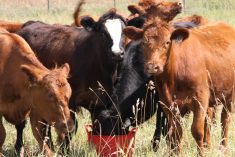Barn conversion costs vary widely; researcher says he has heard of costs ranging from $75 to $500 per pig
About 15 percent of Canadian hog producers have converted their barns to loose housing.
The national pig code of practice dictates that all barns with gestation stalls must convert by 2024 and any new builds or major reconstruction must incorporate group sow housing.
Ken Engel of the Prairie Swine Centre said producers are working toward those requirements and since many existing barns were built sometime in the 1990s, “if you need to do a barn renovation, now might be the right time to sort of consider it.
Read Also

Animal protection delivery to change in Saskatchewan
The Saskatchewan government is looking for a new agency to handle animal welfare after Animal Protection Services of Saskatchewan decided not to renew its contract next year.
“Everybody that I’ve talked to who has made a conversion is happy with the conversion. There’s nobody who wants to go back,” he told those at a March 15 Alberta Pork regional meeting in Lethbridge.
Costs for a barn conversion vary widely, he said. Much depends on what’s there already and what improvements or options producers want to incorporate. Engel said he’s heard of conversions costing $75 per pig and some costing $500 per pig.
But while most producers wait until their barns are old enough to require renovation, those at Hartland Hutterite Colony near Bashaw, Alta., did their conversion on a barn that was only eight years old.
When the colony was approached to become a multiplier operation for Fast Genetics, members decided to proceed with the conversion.
Martin Waldner of Hartland Colony told producers that the renovations cost an estimated $450 per sow and incorporated various options that are working well.
Before barn conversion, the colony had 620 gestation stalls. Waldner said it could now accommodate 700 sows in the same area, though it doesn’t run that many at present.
Calmer sows, bigger piglets at birth and much lower noise levels are among the improvements, said Waldner.
“When we walk into our gestation area now, those sows don’t even get up.”
Both Engel and Waldner said advance planning is crucial to successful conversion. Hartland planned for more than a year before starting the work and continued production during construction, though it reduced the herd by half before starting.
The colony opted for a dynamic group system using electronic sow feeders. The system is capable of blending two different rations at once, supplying medication and spray marking animals as needed.
“The most important thing for electronic sow feeding systems is training gilts and sows,” said Waldner. “You need a training area. No system can or will work without the training.”
That involves training the pigs to use the feeders and training the staff to work in a loose housing system, he added.
By far, the most important element in a barn conversion from gestation stalls to loose housing is patience, said Waldner.
“If you don’t have it, you’re fighting a losing battle.”
Engel said there are various types of loose housing systems, so producers must consider all options before taking the plunge.
They must decide on competitive versus non-competitive feeding systems, flooring type and pen design including sleeping space, partitions, feed and water stations.
He cautioned producers to allow sufficient space per sow of no less than 16 sq. feet per pig and ideally at least 24 sq. feet. Space allowances are outlined in the code of practice.
The code also requires producers to provide enrichment in sow pens that supports normal pig behaviour.
Engel said producers may wonder what constitutes adequate enrichment, but it can be as simple as providing straw or even small blocks of wood for the sows to play with.
“Enrichment is cheap, simple and effective,” he said.
The code includes information on pigs’ social, occupational, physical, sensory and nutritional enrichment.















